Philips 55PUK7100, 49PUK7100, 43PUK7100 User Manual

Register your product and get support at
7100 series
www.philips.com/welcome
User Manual
43PUK7100
49PUK7100
55PUK7100

Contents
1 TV Tour |
4 |
|
|
|
|
|
8.5 Text / Teletext |
|
33 |
|
|
|
|
|
|
|
|
|
8.6 Interactive TV |
|
34 |
|
|
|
|||
1.1 Ultra HD TV |
4 |
|
|
|
|
|
|
|
|
|
|||
|
|
|
|
|
9 Top Picks |
36 |
|
|
|
||||
1.2 Philips Android TV™ |
4 |
|
|
|
|
|
|||||||
|
|
|
|
|
|
|
|
|
|||||
1.3 Using Apps |
4 |
|
|
|
|
|
9.1 About Top Picks |
36 |
|
|
|
||
1.4 Playing Games |
|
4 |
|
|
|
9.2 Now on TV |
36 |
|
|
|
|
||
1.5 Movies and missed programmes |
4 |
9.3 TV on Demand |
36 |
|
|
|
|||||||
1.6 Pause TV and Recordings |
4 |
|
9.4 Video on Demand |
37 |
|
|
|||||||
1.7 Social Networks |
|
5 |
|
|
|
10 Sources |
38 |
|
|
|
|
||
1.8 Ambilight |
5 |
|
|
|
|
|
|
|
|
|
|||
|
|
|
|
|
10.1 Switch to a device |
|
|
|
|
||||
1.9 Ambilight + Hue |
|
5 |
|
|
|
38 |
|
|
|||||
2 Setting Up |
6 |
|
|
|
|
|
10.2 Device Detection |
38 |
|
|
|
||
|
|
|
|
|
10.3 One Touch Play |
38 |
|
|
|
||||
2.1 Read Safety |
6 |
|
|
|
|
|
|
|
|
||||
|
|
|
|
|
11 Apps |
39 |
|
|
|
|
|
||
2.2 TV Stand and Wall Mounting |
6 |
|
|
|
|
|
|||||||
11.1 About Apps |
|
|
|
|
|
||||||||
2.3 Tips on Placement |
|
6 |
|
|
39 |
|
|
|
|
||||
2.4 Power Cable |
6 |
|
|
|
|
|
11.2 Install an App |
|
39 |
|
|
|
|
2.5 Antenna Cable |
|
6 |
|
|
|
11.3 Start an App |
39 |
|
|
|
|||
2.6 Satellite Dish |
7 |
|
|
|
|
12 Videos, Photos and Music |
40 |
||||||
3 Network |
8 |
|
|
|
|
|
|||||||
|
|
|
|
|
12.1 From a USB Connection |
40 |
|
||||||
|
|
|
|
|
|
|
|
||||||
3.1 Smart TV and Internet |
|
8 |
|
12.2 From a Computer or NAS |
40 |
|
|||||||
3.2 Connect to Network |
8 |
|
|
13 3D |
41 |
|
|
|
|
|
|||
3.3 Network Settings |
|
9 |
|
|
|
|
|
|
|
|
|||
|
|
|
|
13.1 What You Need |
|
|
|
|
|||||
3.4 Network Devices |
|
10 |
|
|
|
41 |
|
|
|
||||
3.5 File Sharing |
10 |
|
|
|
|
|
13.2 3D Glasses |
41 |
|
|
|
|
|
4 Connections |
|
11 |
|
|
|
13.3 3D Settings |
41 |
|
|
|
|||
|
|
|
|
13.4 Optimal 3D Viewing |
41 |
|
|
||||||
|
|
|
|
|
|
|
|
|
|||||
4.1 Tips on Connections |
11 |
|
13.5 Care of the 3D Glasses |
41 |
|
|
|||||||
4.2 CI+ CAM with Smart Card |
13 |
|
13.6 Health Warning |
42 |
|
|
|
||||||
4.3 Receiver - Set-Top Box |
|
14 |
|
14 Multi View |
43 |
|
|
|
|||||
4.4 Home Theatre System - HTS |
15 |
|
|
|
|||||||||
14.1 Text and TV |
|
|
|
|
|
||||||||
4.5 Blu-ray Disc Player |
|
16 |
|
|
43 |
|
|
|
|||||
4.6 DVD Player |
16 |
|
|
|
|
|
14.2 App Gallery and TV |
43 |
|
|
|||
4.7 Headphones |
17 |
|
|
|
14.3 HDMI and TV |
|
43 |
|
|
|
|||
4.8 Game Consoles |
|
17 |
|
|
|
15 Settings |
44 |
|
|
|
|
||
4.9 Gamepad |
17 |
|
|
|
|
|
|
|
|
|
|||
|
|
|
|
|
15.1 Picture |
|
|
|
|
|
|
||
4.10 USB Hard Drive |
|
18 |
|
|
|
44 |
|
|
|
|
|
||
4.11 USB Keyboard |
|
18 |
|
|
|
15.2 Sound |
49 |
|
|
|
|
|
|
4.12 USB Flash Drive |
|
19 |
|
|
|
15.3 Ambilight |
52 |
|
|
|
|
||
4.13 Photo Camera |
|
19 |
|
|
|
15.4 Eco Settings |
54 |
|
|
|
|||
4.14 Camcorder |
19 |
|
|
|
|
15.5 General Settings |
55 |
|
|
|
|||
4.15 Computer |
20 |
|
|
|
|
|
15.6 Clock, Region and Language |
|
58 |
||||
5 Switching On and Off |
21 |
|
15.7 Universal Access |
61 |
|
|
|
||||||
|
15.8 Wireless and Networks |
62 |
|
|
|||||||||
|
|
|
|
|
|
|
|
|
|||||
5.1 On or standby |
21 |
|
|
|
15.9 Android Settings |
62 |
|
|
|
||||
5.2 Philips Logo Brightness |
|
21 |
|
16 Channel Installation |
64 |
|
|||||||
5.3 Keys on TV |
21 |
|
|
|
|
|
|
||||||
|
|
|
|
|
16.1 Antenna/Cable Installation |
|
|
||||||
5.4 Sleep Timer |
21 |
|
|
|
|
64 |
|
||||||
5.5 Switch Off Timer |
|
21 |
|
|
|
16.2 Satellite Installation |
67 |
|
|
||||
6 Remote Control |
|
|
23 |
|
17 Software |
71 |
|
|
|
|
|||
6.1 Key overview |
23 |
|
|
|
17.1 Update Software |
71 |
|
|
|
||||
6.2 Keyboard |
24 |
|
|
|
|
|
17.2 Software Version |
71 |
|
|
|
||
6.3 Link up with the TV |
|
25 |
|
|
17.3 Open Source Software |
71 |
|
|
|||||
6.4 IR Sensor |
26 |
|
|
|
|
|
17.4 Open Source License |
71 |
|
|
|||
6.5 Batteries |
26 |
|
|
|
|
|
17.5 Announcements |
106 |
|
|
|
||
6.6 Cleaning |
26 |
|
|
|
|
|
18 Specifications |
107 |
|
|
|||
7 Home and TV menu |
|
27 |
|
|
|
||||||||
|
|
18.1 Environmental |
107 |
|
|
|
|||||||
|
|
|
|
|
|
|
|
|
|
||||
7.1 Open the Home Menu |
|
27 |
|
18.2 Power |
107 |
|
|
|
|
||||
8 Channels |
28 |
|
|
|
|
18.3 Operating System |
108 |
|
|
||||
|
|
|
|
18.4 Reception |
108 |
|
|
|
|||||
|
|
|
|
|
|
|
|
|
|
||||
8.1 Channel Lists |
28 |
|
|
|
18.5 Display |
108 |
|
|
|
|
|||
8.2 Watching Channels |
|
29 |
|
|
18.6 Dimensions and Weights |
108 |
|
||||||
8.3 Favourite Channels |
|
31 |
|
|
18.7 Connectivity |
109 |
|
|
|
||||
8.4 TV Guide |
32 |
|
|
|
|
|
18.8 Sound |
109 |
|
|
|
|
|
2
18.9 Multimedia |
109 |
19 Help and Support |
110 |
|
19.1 Register |
110 |
|
19.2Troubleshooting 110
19.3Help 111
19.4 |
Online Help |
111 |
|
19.5 |
Repair |
112 |
|
20 Safety and Care |
113 |
|
|||
20.1 Safety |
113 |
|
|
|
|
20.2 Screen Care |
114 |
|
|
||
21 Terms of Use_TV |
115 |
||||
22 Terms of Use_Smart TV |
116 |
||||
23 Copyrights |
117 |
|
|||
23.1 Ultra HD |
117 |
|
|
||
23.2 |
HDMI |
117 |
|
|
|
23.3 |
Dolby Digital Plus |
117 |
|
||
23.4 |
DTS Premium Sound ™ |
117 |
|||
23.5 |
DLNA Certified® |
117 |
|
||
23.6 Microsoft |
|
117 |
|
|
|
23.7 |
Wi-Fi Alliance |
118 |
|
||
23.8 Kensington |
118 |
|
|
||
23.9 Other Trademarks |
118 |
|
|||
Index 119
3

1
TV Tour
1.1
Ultra HD TV
This TV has an Ultra HD display. Its resolution is four times as much as normal HD displays. Ultra HD means 8 million pixels for the most refined and lifelike picture on TV.
On top, the new Ultra Pixel HD Engine continuously converts any incoming TV signal into Ultra HD resolution. So you can enjoy this stunning picture quality the moment you switch on the TV. Or you can watch native Ultra HD videos through an HDMI connection. Ultra HD offers TV viewing that is crisp and sharp even on a big screen.
1.2
Philips Android TV™
This a Philips Android TV™ with UHD.
Android TV offers thousands of movies, shows and games from Google Play, YouTube and your favourite apps.*
Personalised recommendations mean more time being entertained and less time hunting for something good. With Google Cast built in, you can easily cast movies, shows and photos from your Chromebook or Android device to your TV.**
With the Philips TV Remote App on your smartphone or tablet, you have your TV channels at your fingertips. Send a photo to the large TV screen or follow your favourite cooking show on your tablet in the kitchen. From now on your TV is part of your mobile household.
Connect the TV to your home network and the Internet.
* The TV must be connected to the
Internet. Subscriptions might be required for certain content providers.
** Casting optimized for selected services only. Streaming quality for other content might vary. Supported operating systems and devices: Android 2.3 and higher, iOS® 7 and higher, Windows® 7 and higher, Mac OS® 10.7 and higher and Chrome OS (version 38 or higher).
Google, Android, Google Play and other marks are trademarks of Google Inc. The Android robot is reproduced or modified from work created and shared by Google and used according to terms described in the Creative Commons 3.0 Attribution License.
http://creativecommons.org/licenses/by/3.0/legalco de
1.3
Using Apps
To get you started, some practical Apps are preinstalled on your TV.
The Apps pages show the collection of Apps (Applications) on your TV. Like Apps on your smartphone or tablet, the Apps on your TV offer specific functions for an enriched TV experience. Apps like TV games or weather forecasts (a.o.). Or start an Internet Browser App to surf the Internet.
For more information, press Keywords and look up Apps.
1.4
Playing Games
This TV is your big screen for gaming. Big enough for two.
You can play a game from a connected Game Console, a game from an installed App or simply an online game on a website. You can set the TV to the ideal settings for gaming, to allow quick and responsive action. If you play a multi-player game with split screens, you can set the TV to show each screen as a full screen simultaneously. Each player can focus on his own game to play.
1.5
Movies and missed
programmes
To get a rental video, you don't need to leave the house.
Open Video on Demand and get that latest movie streamed to your TV directly. Open the video store App, create your personal account, select the movie and press play.
Video on Demand is available in selected countries.
For more information, press Keywords and look up Video on Demand.
4

1.6
Pause TV and Recordings
If you connect a USB Hard Drive, you can pause and record a broadcast from a digital TV channel.
Pause your TV and answer that urgent phone call or simply take a break during a sports match, while the TV stores the broadcast on the USB Hard Drive. You can watch it again later.
With a USB Hard Drive connected, you can also record digital broadcasts. You can record while you are watching a programme or schedule a recording of an upcoming programme.
1.7
Social Networks
No need to get up to check your friend's messages on your computer.
On this TV you get the messages from your social network on your TV screen. You can send a return message from your couch.
1.8
Ambilight
Ambilight is the most elegant and exclusive feature of your new Philips TV.
A subtle glow of coloured light that shines from behind the screen - expanding your visual experience. With Ambilight your eyes relax but your mind is fully taken up by what you see.
With Ambilight+hue you even expand Ambilight further. Bringing in the wireless controlled bulbs of Philips Hue*. All of them setup to fill your room with colours that fit what's on TV.
You will miss Ambilight when you switch it off.
* Separately available.
1.9
Ambilight + Hue
Your Ambilight TV
Philips' unique Ambilight technology goes beyond the ordinary. It not only makes your screen seem much wider, it also makes your viewing experience more immersive by projecting an extra-wide glow from the sides of your TV screen onto the surrounding wall. Colour, vibrancy and excitement move beyond the screen and into your living room, bringing with them a more thrilling, intense and immersive viewing
experience.
Ambilight + Hue
Fill your space and your life with the wonder of Ambilight. Ambilight + hue* allows you to extend the Ambilight experience throughout your room.
With Ambilight+hue you even expand Ambilight further. Bringing in the wireless controlled bulbs of Philips Hue*. All of them setup to fill your room with colours that fit what's on TV.
Your Ambilight TV and hue bulbs ‘talk’ wirelessly to each other, surrounding you in the emotion, power and colour of Ambilight.
*Hue kit available separately.
5
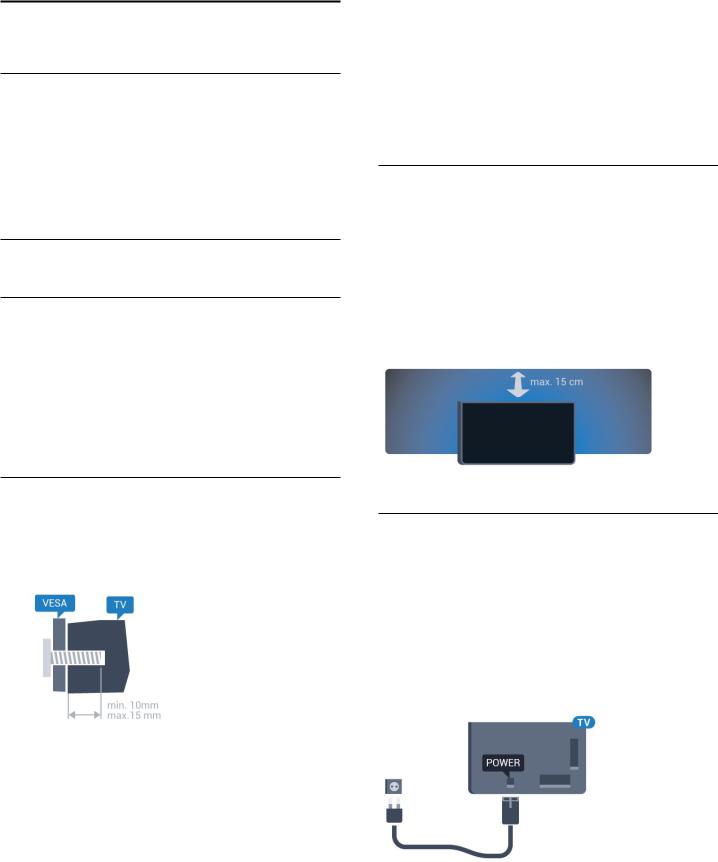
2
Setting Up
2.1
Read Safety
Read the safety instructions first before you use the
TV.
To read the instructions, press the colour
key Keywords and look up Safety instructions.
2.2
TV Stand and Wall Mounting
TV Stand
You can find the instructions for mounting the TV stand in the Quick Start Guide that came with the TV. In case you lost this guide, you can download it from www.philips.com.
Use the product type number of the TV to look for the Quick Start Guide to download.
Wall mounting the TV requires special skills and should only be performed by qualified personnel. The TV wall mounting should meet safety standards according to the TVs weight. Also read the safety precautions before positioning the TV.
TP Vision Europe B.V. bears no responsibility for improper mounting or any mounting that results in accident or injury.
2.3
Tips on Placement
•Position the TV where light does not shine directly on the screen.
•Dim lighting conditions in the room for best Ambilight effect.
•Position the TV up to 15 cm away from the wall.
•The ideal distance to watch TV is 3 times its diagonal screen size. When seated, your eyes should be level with the centre of the screen.
Wall Mounting
Your TV is also prepared for a VESA-compliant wall mount bracket (sold separately).
Use the following VESA code when purchasing the wall mount . . .
• 43PUx7100, 43PUx7150
VESA MIS-F 300x200, M6
• 49PUx7100, 49PUx7150, 49PUx7170, 49PUx7180
VESA MIS-F 300x300, M6
• 55PUx7100, 55PUx7150, 55PUx7170, 55PUx7180
VESA MIS-F 300x300, M6
• 65PUx7120
VESA MIS-F 400x400, M6
Preparation
First remove the 4 plastic screw caps out of the threaded bushes on the back of the TV.
Make sure that the metal screws, to mount the TV to the VESA-compliant bracket, go about 10mm deep inside the threaded bushes of the TV.
Caution
2.4
Power Cable
•Insert the power cable into the POWER connector on the back of the TV.
•Make sure the power cable is securely inserted in the connector.
•Make sure that the power plug, in the wall socket, is accessible at all times.
•When you unplug the power cable, always pull the plug, never pull the cable.
Although this TV has a very low standby power consumption, unplug the power cable to save energy if you do not use the TV for a long period of time.
Press the colour key Keywords and look
up Switching On for more information on switching the TV on or off.
6

2.5
Antenna Cable
Insert the antenna plug firmly into
the Antenna socket at the back of the TV.
You can connect your own antenna or an antenna signal from an antenna distribution system. Use an IEC Coax 75 Ohm RF antenna connector.
Use this antenna connection for DVB-T and DVB-C input signals.
2.6
Satellite Dish
Attach the satellite F-type connector to the satellite connection SAT at the back of the TV.
7

3
Network
3.1
Smart TV and Internet
No Smart TV without the Internet.
This Smart TV is no smart TV without being connected to your home network and the Internet. We recommend to connect to the Internet the moment you start using your new Smart TV. Benefits are countless.
You can connect your TV wirelessly or wired to your network router.
3.2
Connect to Network
Wireless Connection
What You Need
To connect the TV to the Internet wirelessly, you need a Wi-Fi router with a connection to the Internet.
Use a high-speed (broadband) connection to the Internet.
Make the Connection
Wireless
To make a wireless connection…
1 - |
Press , select |
All Settings and press OK. |
2 - |
Select Wireless and Networks and |
|
press (right) to enter the menu. |
||
3 - |
Select Wired or Wi-Fi > Connect to |
|
Network and press |
OK. |
|
4 - |
Select Wireless and press OK. |
|
5 - |
In the list of found networks, select on your |
|
wireless network. If your network is not in the list
because the network name is hidden (you switched off the SSID broadcast of the router), select Add New Network to enter the network name yourself.
6 - Depending on the type of router, enter your encryption key - WEP, WPA or WPA2. If you entered the encryption key for this network before, you can select OK to make the connection immediately.
7 - A message will be shown when the connection is successful.
WPS
If your router has WPS, you can directly connect to the router without scanning for networks. If you have devices in your wireless network that use the WEP security encryption system, you cannot use WPS.
1 - |
Press , select |
All Settings and press OK. |
|
2 - |
Select Wireless and Networks and |
||
press (right) to enter the menu. |
|||
3 - |
Select Wired or Wi-Fi > |
Connect to |
|
Network and press |
OK. |
|
|
4 - |
Select WPS then press |
OK. |
|
5 - |
Go to the router, press the WPS button and return |
||
to the TV within 2 minutes. |
|
||
6 - |
Select Connect to make the connection. |
||
7 - |
A message will be shown when the connection is |
||
successful.
WPS with PIN Code
If your router has WPS with a PIN code, you can directly connect to the router without scanning for networks. If you have devices in your wireless network that use the WEP security encryption system, you cannot use WPS.
1 - |
Press , select |
All Settings and press |
OK. |
2 - |
Select Wireless and Networks and |
|
|
press (right) to enter the menu. |
|
||
3 - |
Select Wired or Wi-Fi > Connect to |
|
|
Network and press |
OK. |
|
|
4 - |
Select WPS with PIN code and press |
OK. |
|
5 - |
Write down the 8-digit PIN code shown on |
||
screen and enter it in the router software on your PC. Consult the router manual on where to enter the PIN code in the router software.
6 - |
Select Connect to make the connection. |
7 - |
A message will be shown when the connection is |
successful.
Problems
Wireless network not found or distorted
•Microwave ovens, DECT phones or other Wi-Fi 802.11b/g/n devices in your proximity might disturb the wireless network.
•Make sure that the firewalls in your network allow access to the TV's wireless connection.
•If the wireless network does not work properly in your home, try the wired network installation.
8
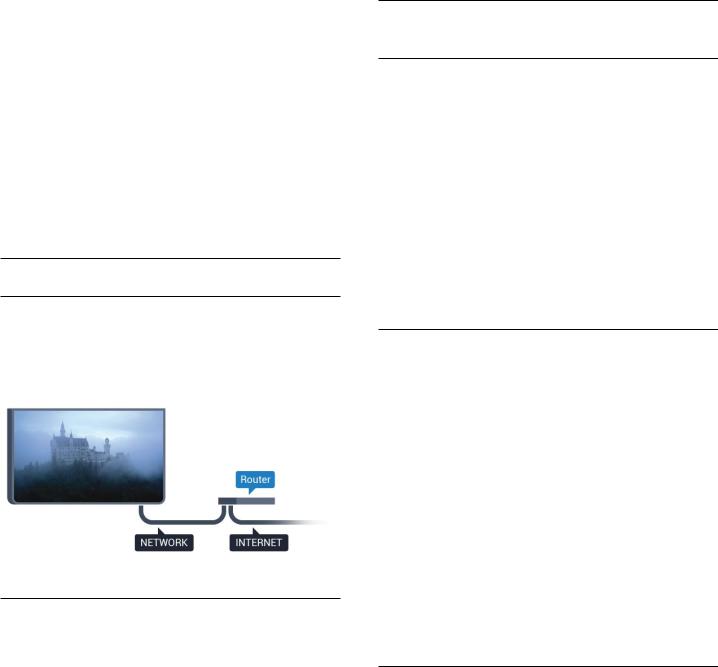
Internet does not work
• If the connection to the router is OK, check the router connection to the Internet.
The PC and Internet connection are slow
•Look in your wireless router's user manual for information on indoor range, transfer rate and other factors of signal quality.
•Use a high-speed (broadband) Internet connection for your router.
DHCP
• If the connection fails, you can check the DHCP (Dynamic Host Configuration Protocol) setting of the router. DHCP should be switched on.
Wired Connection
What You Need
To connect the TV to the Internet, you need a network router with a connection to the
Internet. Use a high-speed (broadband) connection to the Internet.
Make the Connection |
|
||
To make a wired connection… |
|
||
1 - |
Connect the router to the TV with a network cable |
||
(Ethernet cable**). |
|
|
|
2 - |
Make sure that the router is switched on. |
||
3 - |
Press , select |
All Settings and press OK. |
|
4 - |
Select Wireless and Networks and |
||
press (right) to enter the menu. |
|||
5 - |
Select Wired or Wi-Fi > |
Connect to |
|
Network and press |
OK. |
|
|
6 - |
Select Wired and press |
OK. The TV constantly |
|
searches for the network connection. |
|||
7 - |
A message will be shown when the connection is |
||
successful. |
|
|
|
If the connection fails, you can check the DHCP setting of the router. DHCP should be switched on.
**To fulfill EMC regulations, use a shielded FTP Cat. 5E Ethernet cable.
3.3
Network Settings
View Network Settings
You can view all current network settings here. The IP and MAC address, signal strength, speed, encryption method, etc.
To view the current network settings…
1 - |
Press |
, select All Settings and press OK. |
2 - |
Select |
Wireless and Networks and |
press (right) to enter the menu. |
||
3 - |
Select |
Wired or Wi-Fi > View Network |
Settings and press OK. |
||
4 - |
Press |
(left) repeatedly if necessary, to close |
the menu. |
|
|
Network Configuration
If you are an advanced user and want to install your network with Static IP addressing, set the TV to Static IP.
To set the TV to Static IP…
1 - |
Press |
, select All Settings and press OK. |
2 - |
Select |
Wireless and Networks and |
press (right) to enter the menu. |
||
3 - |
Select |
Wired or Wi-Fi > Network |
Configuration and press OK. |
||
4 - |
Select |
Static IP and press OK to enable Static |
IP Configuration. |
||
5 - |
Select |
Static IP Configuration and configure the |
connection. |
||
6 - |
Press |
(left) repeatedly if necessary, to close |
the menu. |
|
|
Switch on with network
You can switch this TV on from your smartphone or tablet if the TV is in Standby. The setting Switch On with Wi-Fi (WoWLAN) must be switched on.
To switch on WoWLAN…
1 - |
Press |
, select All Settings and press OK. |
2 - |
Select Wireless and Networks and |
|
press (right) to enter the menu. |
||
3 - |
Select |
Wired or Wi-Fi > Switch On with Wi-Fi |
(WoWLAN) and press OK. |
||
4 - |
Select |
On and press OK. |
5 - |
Press |
(left) repeatedly if necessary, to close |
the menu.
9

Switch on Wi-Fi connection
You can switch on or off Wi-Fi connection on your TV.
To switch on Wi-Fi…
1 - |
Press |
, select All Settings and press OK. |
2 - |
Select |
Wireless and Networks and |
press (right) to enter the menu. |
||
3 - |
Select |
Wired or Wi-Fi > Wi-Fi On/Off and |
press OK. |
|
|
4 - |
Select |
On and press OK. |
5 - |
Press |
(left) repeatedly if necessary, to close |
the menu.
Digital Media Renderer - DMR
If your media files do not play on your TV, make sure that the Digitial Media Renderer is switched on. As a factory setting, DMR is switched on.
To switch on DMR…
1 - |
Press |
, select All Settings and press OK. |
2 - |
Select |
Wireless and Networks and |
press (right) to enter the menu. |
||
3 - |
Select |
Wired or Wi-Fi > Digital Media Renderer |
- DMR and press OK. |
||
4 - |
Select |
On and press OK. |
5 - |
Press |
(left) repeatedly if necessary, to close |
the menu.
Wi-Fi Smart Screen
To watch digital TV channels on your smartphone or tablet with the Philips TV Remote App, you must switch on Wi-Fi Smart Screen. Some scrambled channels might not be available on your mobile device.
To switch on Wi-Fi Smart Screen…
1 - |
Press |
, select All Settings and press OK. |
2 - |
Select Wireless and Networks and |
|
press (right) to enter the menu. |
||
3 - |
Select |
Wired or Wi-Fi > Wi-Fi Smart |
Screen and press OK. |
||
4 - |
Select |
On and press OK. |
5 - |
Press |
(left) repeatedly if necessary, to close |
the menu.
TV Network Name
If you have more than one TV in your home network, you can give the TV a unique name.
To change the TV name…
1 - |
Press , select All Settings and press OK. |
2 - |
Select Wireless and Networks and |
press (right) to enter the menu. |
|
3 - |
Select Wired or Wi-Fi > TV Network Name and |
press OK. |
|
4 - |
Enter the name with the on-screen keyboard or |
the remote control keyboard (if available). |
|
5 - |
Select to confirm the change. |
6 - |
Press (left) repeatedly if necessary, to close |
the menu.
Clear Internet Memory
With Clear Internet Memory you clear all Internet files stored on your TV. You clear your Philips Smart TV registration and parental rating settings, your video store app logins, all Smart TV app favourites, Internet bookmarks and history. Interactive MHEG applications can also save so-called 'cookies', on your TV. These files will also be cleared.
To clear the Internet memory…
1 - |
Press |
, select |
All Settings and press OK. |
2 - |
Select Wireless and Networks and |
||
press (right) to enter the menu. |
|||
3 - |
Select |
Wired or Wi-Fi > Clear Internet |
|
Memory and press |
OK. |
||
4 - |
Select |
OK to confirm. |
|
5 - |
Press |
(left) repeatedly if necessary, to close |
|
the menu.
3.4
Network Devices
The TV can connect to other devices in your wireless network, like your computer or smartphone. You can use a computer with Microsoft Windows or Apple OS X.
3.5
File Sharing
On this TV, you can open photos, music and videos stored on your computer.
10
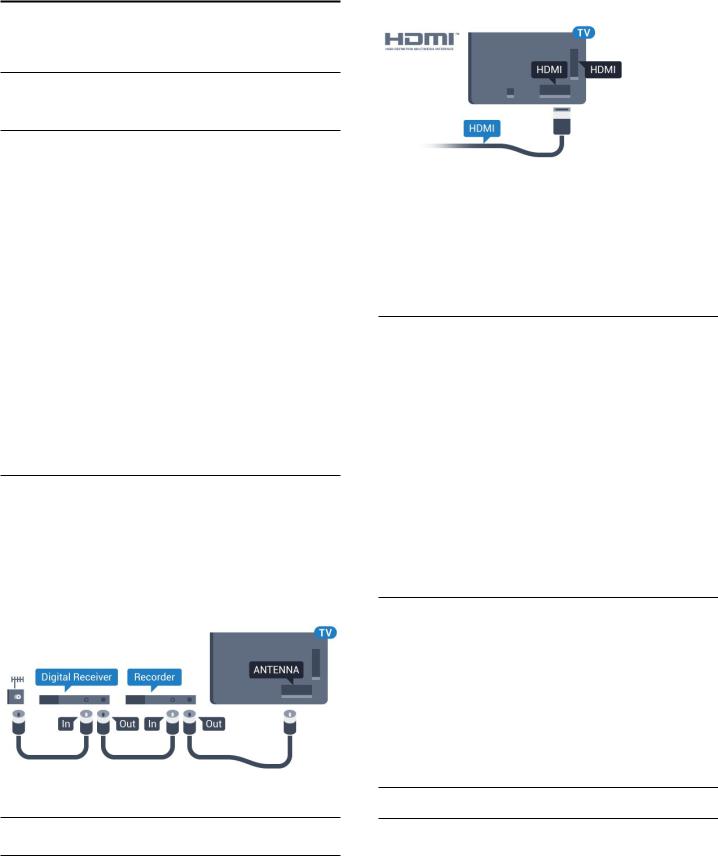
4
Connections
4.1
Tips on Connections
Connectivity Guide
Always connect a device to the TV with the highest quality connection available. Also, use good quality cables to ensure a good transfer of picture and sound.
When you connect a device, the TV recognizes its type and gives each device a correct type name. You can change the type name if you wish. If a correct type name for a device is set, the TV automatically switches to the ideal TV settings when you switch to this device in the Sources menu.
If you need help to connect several devices to the TV, you can visit the Philips TV connectivity guide. The guide offers information on how to connect and which cables to use.
Go to www.connectivityguide.philips.com
Antenna port
If you have a Set-top box (a digital receiver) or Recorder, connect the antenna cables to run the antenna signal through the Set-top box and/or Recorder first before it enters the TV. In this way, the antenna and the Set-top box can send possible additional channels to the Recorder to record.
than 5 m.
Copy protection
HDMI cables support HDCP (High-bandwidth Digital Content Protection). HDCP is a copy protection signal that prevents copying content from a DVD disc or Bluray Disc. Also referred to as DRM (Digital Rights Management).
HDMI ARC
All of the HDMI connections on the TV have HDMI ARC (Audio Return Channel).
If the device, typically a Home Theatre System (HTS), also has the HDMI ARC connection, connect it to any of the HDMI connections on this TV. With the HDMI ARC connection, you do not need to connect the extra audio cable that sends the sound of the TV picture to the HTS. The HDMI ARC connection combines both signals.
You can use any HDMI connection on this TV to connect the HTS but ARC is only available for 1 device/connection at a time.
HDMI Ultra HD
You can watch videos filmed or made in 'native' Ultra HD resolution - 3840x2160 pixels - on this TV.
Connect a Blu-ray Disc player, game console or computer that plays Ultra HD videos to one of HDMI connections. Use a High speed HDMI cable to connect. The HDMI UHD connections have ARC (Audio Return Channel).
HDMI ports
HDMI Quality
An HDMI connection has the best picture and sound quality. One HDMI cable combines video and audio signals. Use an HDMI cable for High Definition (HD) or Ultra HD (UHD) TV signals.
For best signal quality transfer, use a High speed HDMI cable and do not use an HDMI cable longer
HDMI CEC - EasyLink
EasyLink
An HDMI connection has the best picture and sound quality. One HDMI cable combines video and audio signals. Use an HDMI cable for High Definition (HD) or Ultra HD (UHD) TV signals. For best signal quality transfer, use a High speed HDMI cable and do not use an HDMI cable longer than 5 m.
11
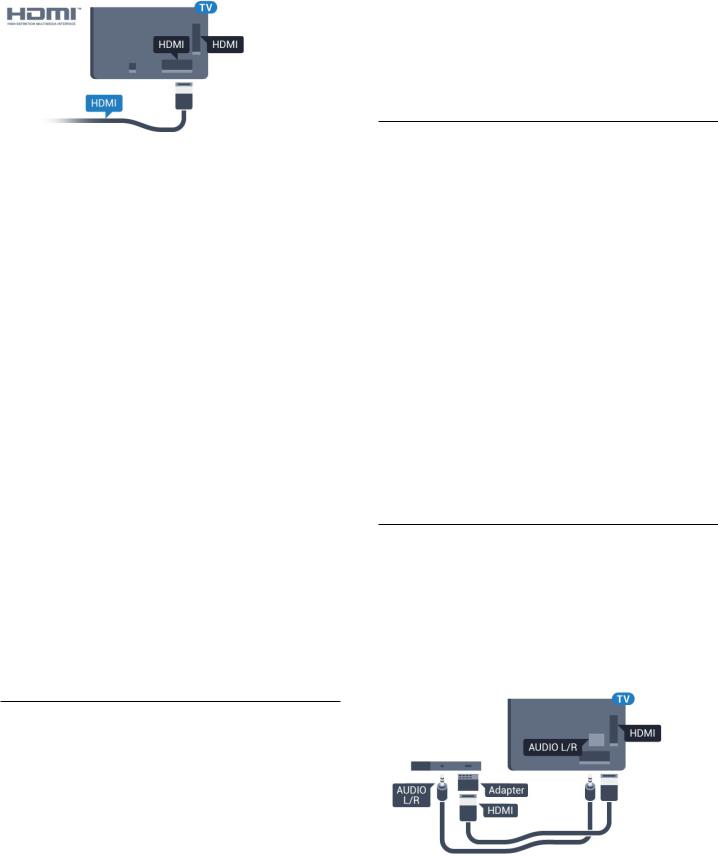
EasyLink HDMI CEC
If your devices are connected with HDMI and have EasyLink, you can operate them with the TV remote control. EasyLink HDMI CEC must be switched On on the TV and the connected device.
With EasyLink you can operate a connected device with the TV remote control. EasyLink uses HDMI CEC (Consumer Electronics Control) to communicate with the connected devices. Devices must support HDMI CEC and must be connected with an HDMI connection.
EasyLink setup
The TV comes with EasyLink switched on. Make sure that all HDMI CEC settings are properly set up on the connected EasyLink devices. EasyLink might not work with devices from other brands.
HDMI CEC on other brands
The HDMI CEC functionality has different names on different brands. Some examples are: Anynet, Aquos Link, Bravia Theatre Sync, Kuro Link, Simplink and Viera Link. Not all brands are fully compatible with EasyLink.
Example HDMI CEC branding names are property of their respective owners.
For more information on using EasyLink, press the colour key Keywords and look up EasyLink HDMI CEC.
Operate Devices
To operate a device connected to HDMI and set up with EasyLink, select the device or its activity in the list of TV connections. Press SOURCES , select a device connected to an HDMI connection and press OK.
Once the device is selected, the TV remote control can control the device. However the
keys HOME and OPTIONS and some other TV keys, like Ambilight , are not forwarded to the device.
If the key you need is not on the TV remote control, you can select the key in the Options menu.
Press OPTIONS and select Controls in the menu bar. On the screen, select the device key you need and press OK.
Some very specific device keys might not be available in the Controls menu.
Only devices that support EasyLink Remote Control function will respond to the TV remote control.
EasyLink Settings
The TV comes with the EasyLink settings switched on.
EasyLink
To switch off EasyLink completely…
1 - |
Press |
, select All Settings and press OK. |
2 - |
Select |
TV Settings and press (right) to enter |
the menu. |
|
|
3 - |
Select |
EasyLink, press (right) and |
select EasyLink one step further. |
||
4 - Select Off. |
||
5 - |
Press |
(left) repeatedly if necessary, to close |
the menu. |
|
|
EasyLink Remote Control |
||
If you want devices to communicate but you don't want to operate them with the TV remote control, you can switch off EasyLink remote control separately.
In the EasyLink settings menu, select EasyLink Remote Control and select Off.
DVI to HDMI
If you still own a device that only has a DVI connection, you can connect the device to any of the HDMI connection with a DVI to HDMI adapter.
Use a DVI to HDMI adapter if your device only has a DVI connection. Use one of the HDMI connections and add an Audio L/R cable (mini-jack 3.5mm) to Audio In for sound, on the back of the TV.
12

Copy protection
DVI and HDMI cables support HDCP (High-bandwidth Digital Content Protection). HDCP is a copy protection signal that prevents copying content from a DVD disc or Blu-ray Disc. Also referred to as DRM (Digital Rights Management).
Y Pb Pr - Component
Y Pb Pr - Component Video is a high quality connection.
The YPbPr connection can be used for High Definition (HD) TV signals. Next to the Y, Pb and Pr signals add the Audio Left and Right signals for sound.
Match the YPbPr (green, blue, red) connector colours with the cable plugs when you connect.
Use an Audio L/R cinch cable if your device also has sound.
SCART
SCART is a good quality connection.
The SCART connection can be used for CVBS and RGB video signals but cannot be used for High Definition (HD) TV signals. The SCART connection combines video and audio signals. The SCART connection also supports NTSC playback.
Audio Out - Optical
Audio Out - Optical is a high quality sound connection.
This optical connection can carry 5.1 audio channels. If your device, typically a Home Theatre System (HTS), has no HDMI ARC connection, you can use this connection with the Audio In - Optical connection on the HTS. The Audio Out - Optical connection sends the sound from the TV to the HTS.
You can set the type of the audio out signal to fit the audio capabilities of your Home Theatre System. For more information, press Keywords and look up Audio Out Settings.
If the sound does not match the video on screen, you can adjust the audio to video synchronisation.
For more information, press Keywords and look up Audio to Video Sync.
4.2
CI+ CAM with Smart Card
CI+
This TV is ready for the CI+ Conditional Access.
With CI+ you can watch premium HD programmes, like movies and sports, offered by digital TV operators in your region. These programmes are scrambled by the TV operator and descrambled with a prepaid CI+ module.
Digital TV operators provide a CI+ module (Conditional Access Module - CAM) and an accompanying smart card, when you subscribe to their premium programmes. These programmes have a high level of copy protection.
Contact a digital TV operator for more information on terms & conditions.
13
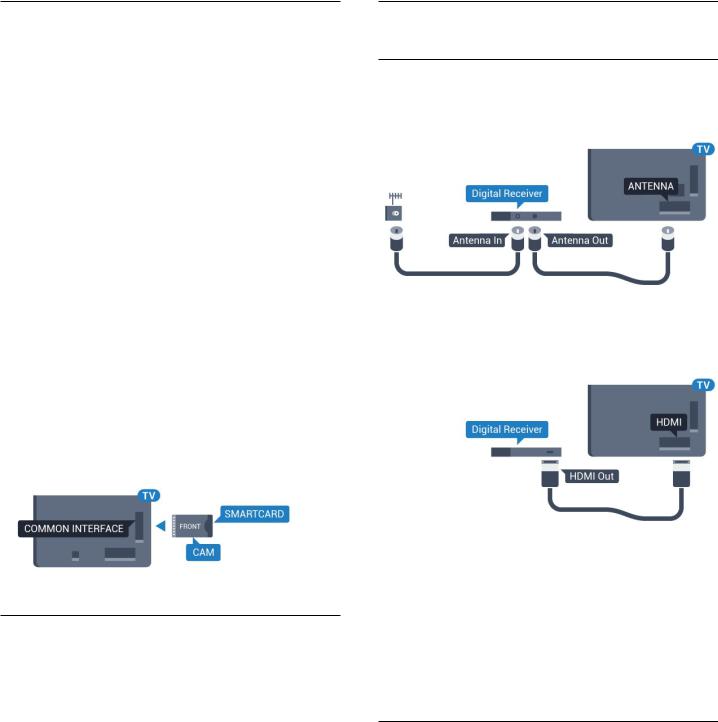
One Smart Card
Digital TV operators provide a CI+ module (Conditional Access Module - CAM) and an accompanying smart card, when you subscribe to their premium programmes.
Insert the smart card into the CAM module. See the instruction you received from the operator.
To insert the CAM in the TV…
1 - Look on the CAM for the correct method of insertion. Incorrect insertion can damage the CAM and TV.
2 - While looking at the back of the TV, with the front of the CAM facing towards you, gently insert the CAM into the slot COMMON INTERFACE.
3 - Push the CAM in as far as it will go. Leave it in the slot permanently.
When you switch on the TV, it may take a few minutes before the CAM is activated. If a CAM is inserted and subscription fees are paid (subscription methods can differ), you can watch the scrambled channels supported by the CAM smart card.
The CAM and smart card are exclusively for your TV. If you remove the CAM, you will no longer be able to watch the scrambled channels supported by the CAM.
Passwords or PIN codes
For some CAMs, you must enter a PIN code to watch its channels. When you set the PIN code for the CAM, we recommend you to use the same code you are using to unlock the TV.
To set the PIN code for the CAM…
1 - |
Press |
SOURCES . |
2 - |
Select the channel type you are using the CAM |
|
for. |
|
|
3 - |
Press |
OPTIONS and select Common |
Interface. |
|
|
4 - |
Select the TV operator of the CAM. The following |
|
screens come from the TV operator. Follow the onscreen instruction to look up the PIN code setting.
4.3
Receiver - Set-Top Box
Cable Box
Use 2 antenna cables to connect the antenna to the Set-top box (a digital receiver) and the TV.
Next to the antenna connections, add an HDMI cable to connect the Set-top box to the TV.
Alternatively, you can use a SCART cable if the Settop box has no HDMI connection.
Switch Off Timer
Switch off this automatic timer, if you only use the remote control of the Set-top box. Switch this timer off to prevent the TV from switching off automatically after a 4 hour period without a key press on the remote control of the TV.
In Help, press the colour key Keywords and look up Switch Off Timer for more information.
Satellite Tuner
Connect the dish antenna cable to the Satellite receiver.
Next to the antenna connection, add an HDMI cable to connect the device to the TV.
Alternatively, you can use a SCART cable if the device has no HDMI connection.
14
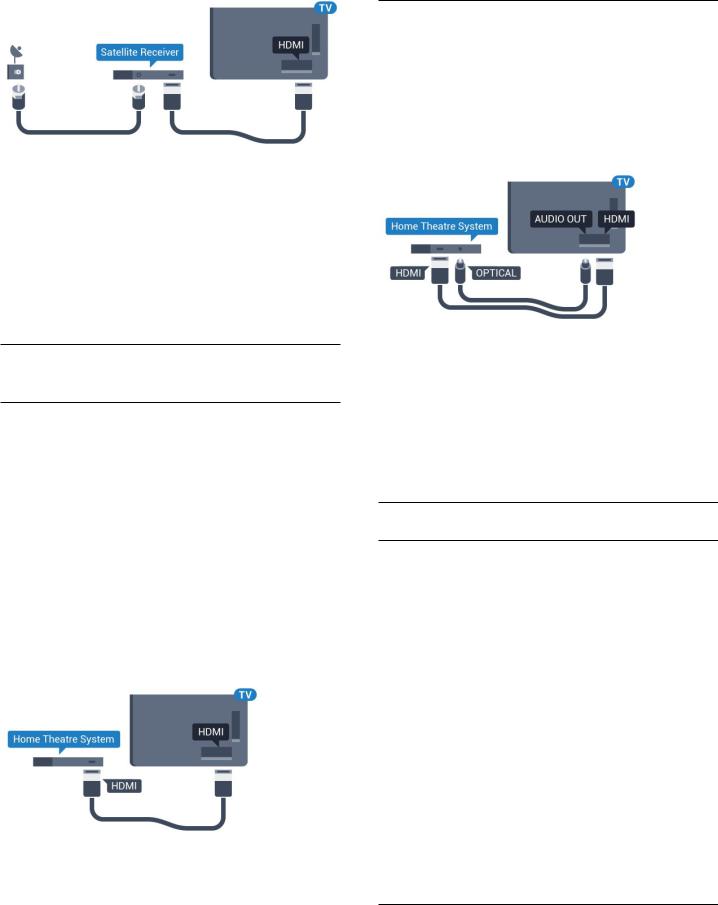
Switch Off Timer
Switch off this automatic timer, if you only use the remote control of the Set-top box. Switch this timer off to prevent the TV from switching off automatically after a 4 hour period without a key press on the remote control of the TV.
In Help, press the colour key Keywords and look up Switch Off Timer for more information.
4.4
Home Theatre System - HTS
Connect with HDMI ARC
Use an HDMI cable to connect a Home Theatre System (HTS) to the TV. You can connect a Philips Soundbar or an HTS with a built-in disc player.
HDMI ARC
If your Home Theatre System has an HDMI ARC connection, you can use any HDMI connection on the TV to connect. With HDMI ARC, you do not need to connect the extra audio cable. The HDMI ARC connection combines both signals.
All HDMI connections on the TV can offer the Audio Return Channel (ARC) signal. But once you have connected the Home Theatre System, the TV can only send the ARC signal to this HDMI connection.
Audio to video synchronisation (sync)
If the sound does not match the video on screen, you can set a delay on most Home Theatre Systems with a disc player to match the sound with the video.
For more information, press the colour
key Keywords and look up Audio to Video Sync.
Connect with HDMI
Use an HDMI cable to connect a Home Theatre System (HTS) to the TV. You can connect a Philips Soundbar or an HTS with a built-in disc player.
If the Home Theatre System has no HDMI ARC connection, add an optical audio cable (Toslink) to send the sound of the TV picture to the Home Theatre System.
Audio to video synchronisation (sync)
If the sound does not match the video on screen, you can set a delay on most Home Theatre Systems with a disc player to match the sound with the video.
For more information, press the colour
key Keywords and look up Audio to Video Sync.
Audio Out Settings
Audio Out Format
If you have a Home Theatre System (HTS)
with multichannel sound processing capabilities like Dolby Digital, DTS® or similar, set the Audio Out Format to Multichannel. With Multichannel, the TV can send the compressed multichannel sound signal from a TV channel or connected player to the Home Theatre System. If you have a Home Theatre System without multichannel sound processing, select Stereo.
To set Audio Out Format…
1 - |
Press |
, select All Settings and press OK. |
2 - |
Select |
Sound and press (right) to enter the |
menu. |
|
|
3 - |
Select |
Advanced > Audio Out Format and |
press OK. |
|
|
4 - |
Select |
Multichannel or Stereo, then press OK. |
5 - |
Press |
(left) repeatedly if necessary, to close |
the menu.
Audio Out Levelling
Use the Audio Out Levelling setting to level the volume (loudness) of the TV and the Home Theatre System when you switch over from one to another.
15

Volume differences can be caused by differences in sound processing.
To level the difference in volume… |
|
||
1 - |
Press |
, select All Settings and press |
OK. |
2 - |
Select |
Sound and press (right) to enter the |
|
menu. |
|
|
|
3 - |
Select |
Advanced > Audio Out Levelling and |
|
press OK. |
|
|
|
4 - |
Select |
More, Medium, or Less, then press OK. |
|
5 - |
If the volume difference is large, select |
More. If |
|
the volume difference is small, select Less. |
|
||
6 - |
Press (left) repeatedly if necessary, to close |
||
the menu. |
|
|
|
Audio Out Levelling affects both the Audio Out - Optical and HDMI ARC sound signals.
Audio Out Delay
With a Home Theatre System (HTS) connected to the TV, the picture on TV and the sound from the HTS should be synchronised.
Automatic audio to video sync
With recent Philips Home Theatre Systems, the audio to video sync is done automatically and always correct.
Audio sync delay
For some Home Theatre Systems you might need to adjust the audio sync delay to synchronise the audio to the video. On the HTS, increase the delay value until there is a match between picture and sound. A delay value of 180ms may be required. Read the user manual of the HTS. With a delay value set up on the HTS, you need to switch off Audio Out Delay on the TV.
To switch off Audio Out Delay…
1 - |
Press |
, select All Settings and press OK. |
2 - |
Select |
Sound and press (right) to enter the |
menu. |
|
|
3 - |
Select |
Advanced > Audio Out Delay and |
press OK. |
|
|
4 - Select Off. |
||
5 - |
Press |
(left) repeatedly if necessary, to close |
the menu.
Audio Out Offset
If you cannot set a delay on the Home Theatre System, you can set the TV to sync the sound. You can set an offset that compensates for the time necessary for the Home Theatre System to process the sound of the TV picture. You can set the value in steps of 5ms. Maximum setting is -60ms.
The Audio Out Delay setting should be switched on.
To synchronise the sound on the TV…
1 - |
Press |
, select All Settings and press OK. |
2 - |
Select |
Sound and press (right) to enter the |
menu. |
|
|
3 - |
Select |
Advanced > Audio Out Offset and |
press OK. |
|
|
4 - |
Use the slider bar to set the sound offset and |
|
press OK. |
|
|
5 - |
Press (left) repeatedly if necessary, to close |
|
the menu. |
|
|
Problems with HTS sound
Sound with loud noise
If you watch a video from a plugged in USB flash drive or connected computer, the sound from your Home Theatre System might be distorted. This noise is heard when the audio or video file has DTS sound but the Home Theatre System has no DTS sound processing. You can fix this by setting the Audio Out Format of the TV to Stereo.
Press for All
Settings > Sound > Advanced > Audio Out
Format.
No sound
If you cannot hear the sound from the TV on your Home Theatre System, check if you connected the HDMI cable to an HDMI ARC connection on the Home Theatre System. All HDMI connections on the TV are HDMI ARC connections.
4.5
Blu-ray Disc Player
Use a High speed HDMI cable to connect the Bluray Disc player to the TV.
If the Blu-ray Disc player has EasyLink HDMI CEC, you can operate the player with the TV remote control.
In Help, press the colour key Keywords and look up EasyLink HDMI CEC for more information.
16
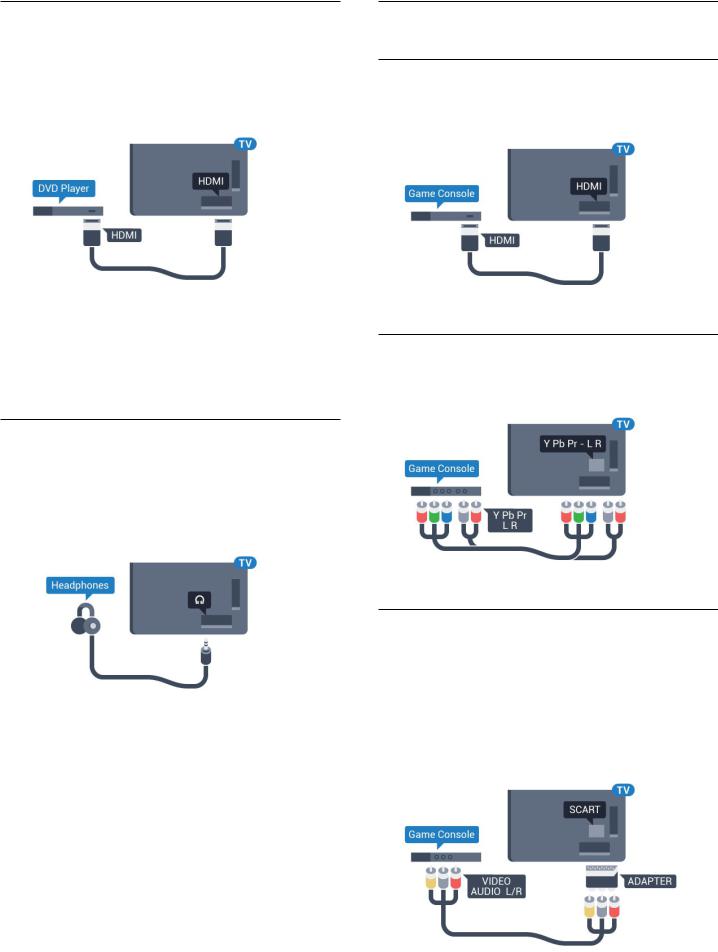
4.6
DVD Player
Use an HDMI cable to connect the DVD player to the TV.
Alternatively, you can use a SCART cable, if the device has no HDMI connection.
If the DVD player is connected with HDMI and has EasyLink CEC, you can operate the player with the TV remote control.
For more information on EasyLink, press the colour key Keywords and look up EasyLink HDMI CEC.
4.7
Headphones
You can connect a set of headphones to
the connection on the back of the TV. The connection is a mini-jack 3.5mm. You can adjust the volume of the headphones separately.
To adjust the volume… |
|
|
||
1 - |
Press |
, select All Settings and press |
OK. |
|
2 - |
Select |
Sound and press (right) to enter the |
||
menu. |
|
|
|
|
3 - |
Select |
Headphone Volume and press |
OK. |
|
4 - |
Press the arrows (up) or |
(down) to adjust |
||
the value. |
|
|
|
|
5 - |
Press (left) repeatedly if necessary, to close |
|||
the menu. |
|
|
|
|
4.8
Game Consoles
HDMI
For best quality, connect the game console with a High speed HDMI cable to the TV.
YPbPr
Connect the game console with a component video cable (Y Pb Pr) and an audio L/R cable to the TV.
Video-Audio LR / Scart
Connect the game console to the TV with a composite cable (CVBS) and an audio L/R cable to the TV.
If your game console only has Video (CVBS) and Audio L/R output, use a Video Audio L/R to SCART adapter (sold separately) to connect to the SCART connection.
17
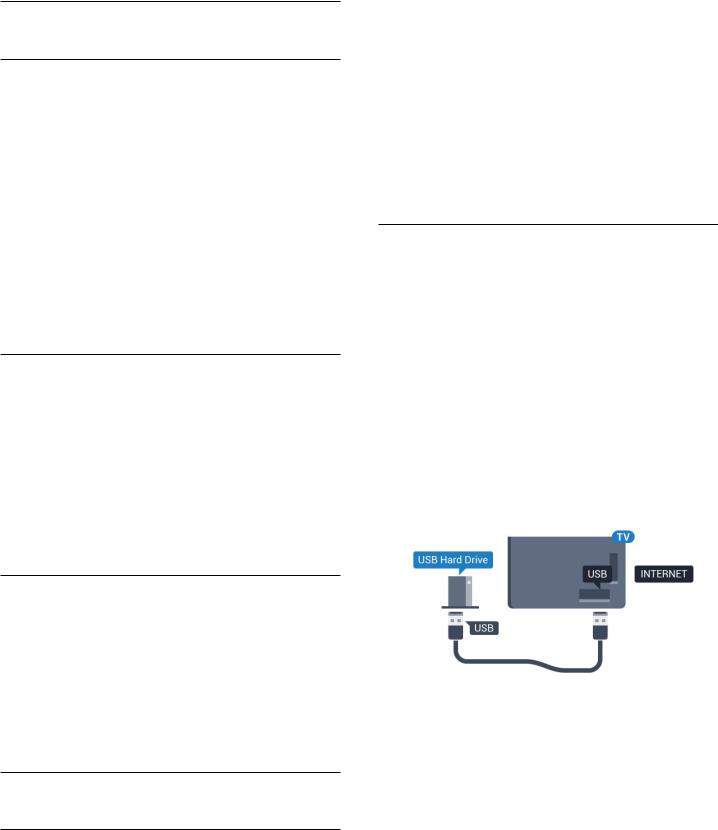
4.9
Gamepad
Connect a Gamepad
To play games from the Internet on this TV, you can connect a selected range of wireless Gamepads. When you connect the Gamepad, you can use it immediately.
To connect a Gamepad…
1 - Plug in the small nano receiver in one of the USB connections on the side of the TV. The wireless nano receiver comes with the Gamepad.
2 - If the Gamepad is switched on, you can use the Gamepad.
You can connect a second Gamepad in the second USB connection on the side of the TV.
Suitable Gamepads
A selected range of wireless Gamepads are suited and tested for use on this TV. Other Gamepads might not be fully compatible.
The suited Gamepads are…
•Logitech F710
•Logitech F510
•Xbox 360 Wireless Controller for Windows
•Speedlink Strike FX Wireless Gamepad
Trouble with Interference
To solve possible interference with other wireless devices on TV…
•Use a USB extension cord and move the nano receiver about 1 meter away from the TV.
•Alternatively, you can use a powered USB hub connected to the TV and plug in the nano receivers in the USB hub.
4.10
USB Hard Drive
What You Need
If you connect a USB Hard Drive, you can pause or record a TV broadcast. The TV broadcast must be a digital broadcast (DVB broadcast or similar).
To Pause
To pause a broadcast, you need a USB 2.0 compatible Hard Drive with a minimum of 4GB disk
space.
To Record
To pause and record a broadcast, you need a minimum of 250GB disk space. If you want to record a broadcast with TV guide data from the Internet, you need to have the Internet connection installed on your TV before you install the USB Hard Drive.
For more information on how to install a USB Hard Drive, press the colour key Keywords and look up USB Hard Drive, Installation.
Installation
Before you can pause or record a broadcast, you must connect and format a USB Hard Drive. Formatting removes all files from the USB Hard Drive.
1 - Connect the USB Hard Drive to one of
the USB connections on the TV. Do not connect another USB device to the other USB ports when formatting.
2 - Switch on the USB Hard Drive and the TV.
3 - When the TV is tuned to a digital TV channel, press (Pause). Trying to pause will start the formatting.
Follow the instructions on screen.
When the USB Hard Drive is formatted, leave it connected permanently.
Warning
The USB Hard Drive is formatted exclusively for this TV, you cannot use the stored recordings on another TV or PC. Do not copy or change recording files on the USB Hard Drive with any PC application. This will corrupt your recordings. When you format another USB Hard Drive, the content on the former will be lost. A USB Hard Drive installed on your TV will need reformatting for use with a computer.
18
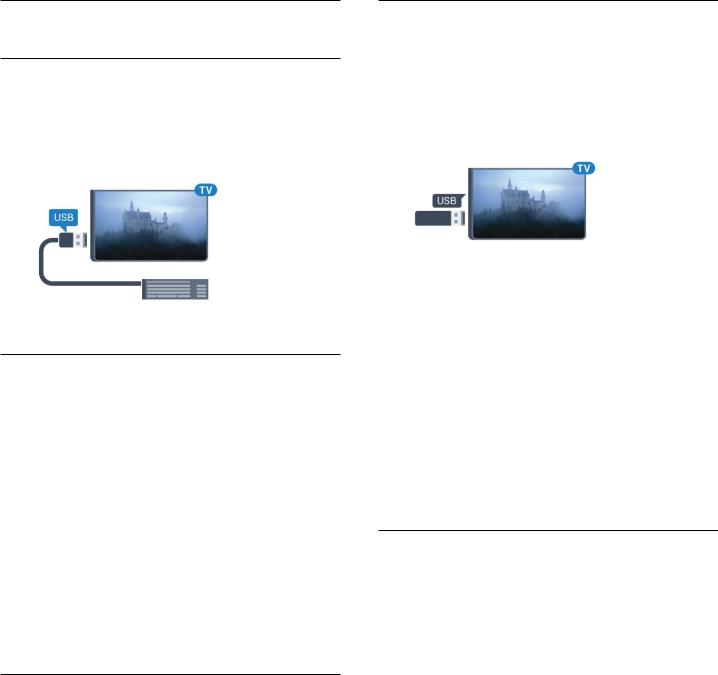
4.11
USB Keyboard
Connect
Connect a USB keyboard (USB-HID type) to enter text on your TV.
You can connect a keyboard and a mouse to the TV. Use one of the USB connections to connect.
Install and configure the Keyboard
To install the USB keyboard, switch on the TV and connect the USB keyboard to one of
the USB connections on the TV. When the TV detects the keyboard for the first time, you can select your keyboard lay-out and test your selection. If you select a Cyrillic or Greek keyboard layout first, you can select a secondary Latin keyboard layout.
To change the keyboard layout setting when a layout was selected…
1 - |
Press |
, select All Settings and press OK. |
2 - |
Select |
General Settings and press (right) to |
enter the menu. |
||
3 - |
Select |
USB Keyboard Settings, and press OK to |
start the keyboard setup.
Special Keys
Keys for entering text
•Enter key = OK
•Backspace = delete character before cursor
•Arrow keys = navigate within a text field
•To switch between keyboard layouts, if a secondary layout is set, press the Ctrl + Spacebar keys simultaneously.
Keys for Smart TV Apps and Internet pages
•Tab and Shift + Tab = Next and Previous
•Home = scroll to the top of the page
•End = scroll to the bottom of the page
•Page Up = jump one page up
•Page Down = jump one page down
•+ = zoom in one step
•- = zoom out one step
•* = fit the web page to the screen width
4.12
USB Flash Drive
You can view photos or play your music and videos from a connected USB flash drive.
Insert a USB flash drive in one of
the USB connections on the TV while the TV is switched on.
The TV detects the flash drive and opens a list showing its content.
If the contents list does not appear automatically, press SOURCES and select USB.
To stop watching the USB flash drive content, press EXIT or select another activity.
To disconnect the USB flash drive, you can pull out the flash drive anytime.
Ultra HD on USB
You can view photos in Ultra HD resolution from a connected USB device or flash drive. The TV will downscale the resolution to Ultra HD if the resolution of the photo is higher.
4.13
Photo Camera
To view photos stored on your digital photo camera, you can connect the camera directly to the TV.
Use one of the USB connections on the TV to connect. Switch on the camera after you made the connection.
If the contents list does not appear automatically, press SOURCES , and select USB.
Your camera might need to be set to transfer its content with PTP (Picture Transfer Protocol). Read the user manual of the digital photo camera.
Ultra HD on USB
You can view photos in Ultra HD resolution from a connected USB device or flash drive. The TV will downscale the resolution to Ultra HD if the resolution of the photo is higher. You cannot play a native Ultra HD video on any of the USB connections.
19
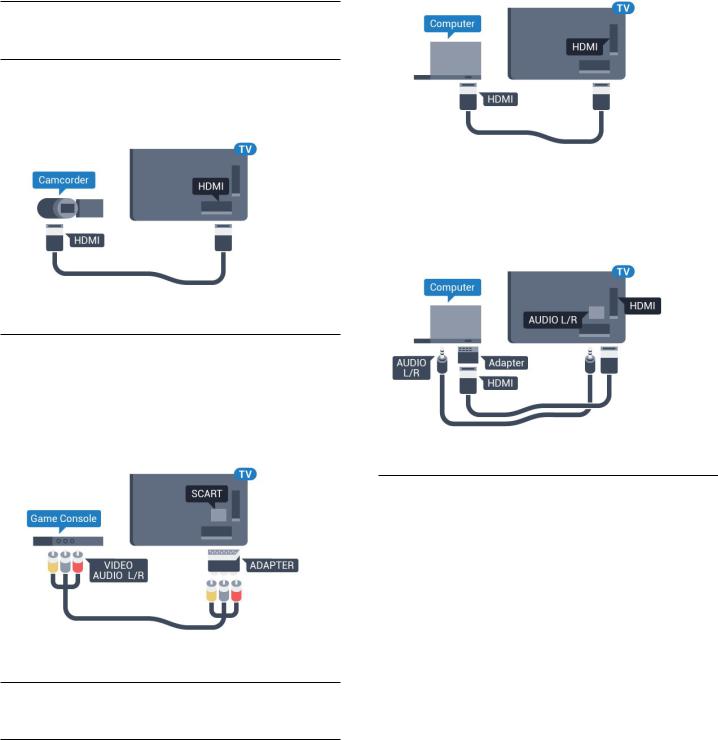
4.14
Camcorder
HDMI
For best quality, use an HDMI cable to connect the camcorder to the TV.
With DVI to HDMI
Alternatively, you can use a DVI to HDMI adapter (sold separately) to connect the PC to HDMI and an audio L/R cable (mini-jack 3.5mm) to AUDIO IN L/R on the back of the TV.
Video-Audio LR / Scart
You can use an HDMI, YPbPr or SCART connection to connect your camcorder. If your camcorder only has Video (CVBS) and Audio L/R output, use a Video Audio L/R to SCART adapter (sold separately) to connect to the SCART connection.
4.15
Computer
Connect
You can connect your computer to the TV and use the TV as a PC monitor.
With HDMI
Use an HDMI cable to connect the computer to the TV.
Settings
If your computer is added as a Computer type of device in the Source menu (the list of connections), the TV is set to the ideal Computer setting automatically.
If you use your computer to watch movies or use it to play games, you might want to set the TV back to the ideal TV watching or gaming setting.
To set the TV to the ideal setting manually…
1 - |
Press |
, select All Settings and press OK. |
2 - |
Select |
Picture and press (right) to enter the |
menu. |
|
|
3 - |
Select |
Advanced > Game or Computer, and |
press OK. |
|
|
4 - |
Select Game (for gaming) or |
|
select Computer (for watching a movie). |
||
5 - |
Press (left) repeatedly if necessary, to close |
|
the menu. |
|
|
Remember to set Game or Computer setting |
||
to |
Off when you stop playing the game. |
|
20

5
Switching On and
Off
5.1
On or standby
Before you switch on the TV, make sure you plugged in the mains power in the POWER connector on the back of the TV.
To put the TV in Standby when the indicator light is off, press the small joystick key on the back of the TV. The indicator will light up.
With the TV in Standby, press on the remote control to switch the TV on. Alternatively, press HOME .
Switch back to Standby
To switch the TV to Standby, press on the remote control.
To switch off the TV completely, disconnect the power plug.
When disconnecting the power plug, always pull the power plug, never the cord. Ensure that you have full access to the power plug, power cord and outlet socket at all times.
5.2
Philips Logo Brightness
You can switch off or adjust the brightness of the Philips logo on the front of the TV.
To adjust or switch off…
1 - |
Press |
, select All Settings and press OK. |
2 - |
Select |
General Settings and press (right) to |
enter the menu. |
||
3 - |
Select |
Philips Logo Brightness, and |
press (right) to enter the menu.
4 - Select Minimum, Medium, Maximum,
or Off to switch off the lighting of the logo, then press OK.
5 - Press the menu.
5.3
Keys on TV
If you lost the remote control or its batteries are empty, you can still do some basic TV operations.
To open the basic menu…
1 - With the TV switched on, press the joystick key on the back of the TV to bring up the basic menu.
2 - Press left or right to
select Volume, Channel or Sources.
3 - Press up or down to adjust the volume or tune to the next or previous channel. Press up or down to go through the list of sources, including the tuner selection. Press the joystick key to slide out the camera.
4 - The menu will disappear automatically.
To switch the TV on standby, select and press the joystick key.
5.4
Sleep Timer
With the Sleep Timer, you can set the TV to switch to Standby automatically after a preset time.
To set the Sleep Timer…
1 - |
Press |
, select All Settings and press OK. |
2 - |
Select |
General Settings and press (right) to |
enter the menu. |
||
3 - |
Select |
Sleep Timer and press (right). With |
the slider bar you can set the time to up to 180 minutes in increments of 5 minutes. If set to 0 minutes, the Sleep Timer is switched off. You can
always switch off your TV earlier or reset the time during the countdown.
4 - Press (left) repeatedly if necessary, to close the menu.
21

5.5
Switch Off Timer
If the TV receives a TV signal but you don't press a key on the remote control during a 4 hour period, the TV switches off automatically to save energy. Also, if the TV does not receive a TV signal nor a remote control command for 10 minutes, the TV switches off automatically.
If you use the TV as a monitor or use a digital receiver to watch TV (a Set-Top Box - STB) and you do not use the remote control of the TV, you should deactivate this automatic switch off.
To deactivate the Switch Off Timer … |
|
|||
1 - |
Press |
, select All Settings and press OK. |
||
2 - |
Select |
General Settings and press |
(right) to |
|
enter the menu. |
|
|
||
3 - |
Select |
Switch Off Timer and press |
OK. |
|
4 - |
Press the arrows (up) or |
(down) to adjust |
||
the value. The value 0 deactivates the automatic switch off.
5 - Press the menu.
For more information on environmentally friendly TV settings, press the colour key Keywords and look up Eco Settings.
22
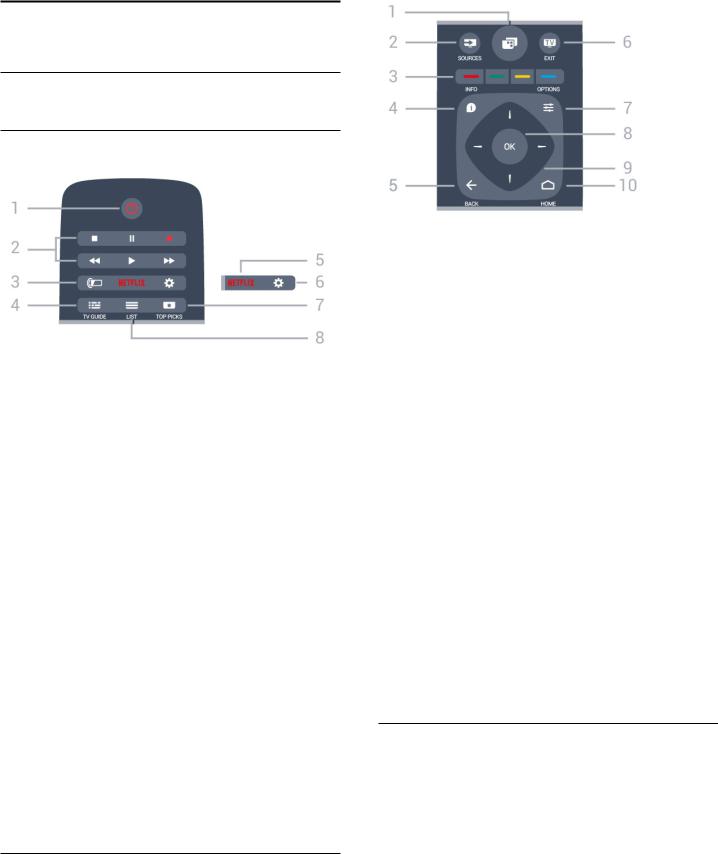
6
Remote Control
6.1
Key overview
Top
1 - Standby / On
To switch the TV on or back to Standby.
2 - Playback and Record
•Play , to playback.
•Pause , to pause playback
•Stop , to stop playback
•Rewind , to rewind
•Fast forward , to go fast forward
•Record , to start recording
3 - Ambilight
To select one of the Ambilight style.
4 - TV GUIDE
To open or close the TV Guide.
5 -
To open the Netflix App directly (if available). With the TV switched on or from standby.
6 - Settings
To open the Settings menu.
7 - TOP PICKS
To get your favourite TV programmes, the newest movies or most used Online TV channels presented as top suggestions.
8 - LIST
To open or close the channel list.
Middle
1 -
To open TV menus.
2 - SOURCES
To open the Sources menu.
3 - Colour keys
Direct selection of options. Blue key , opens Help.
4 - INFO
To open or close programme info.
5 - BACK
To switch back to the previous channel you selected. To close a menu without changing a setting.
To go back to the previous App/Internet page.
6 - - EXIT
To switch back to watching TV. To leave an interactive TV application.
7 - OPTIONS
To open or close the Options menu.
8 - OK key
To confirm a selection or setting.
9 - Arrow / navigation keys
To navigate up, down, left or right.
10 - HOME
To open the Home menu.
Bottom
23
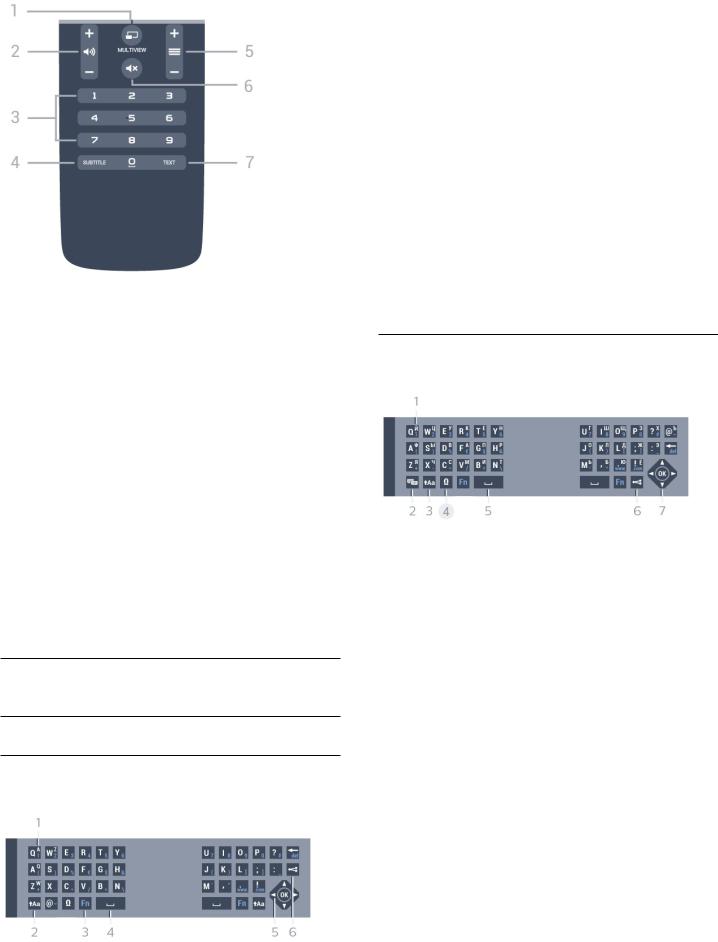
1 - MULTIVIEW
To open an extra small screen.
2 - Volume
To adjust the volume level.
3 - Number keys
To select a channel directly.
4 - SUBTITLE
To switch Subtitles on, off or on during mute.
5 - Channel
To switch to the next or previous channel in the channel list. To open the next or previous page in Text/Teletext. To start the next or previous chapter on a disc.
6 - Mute
To mute the sound or to restore it.
7 - TEXT
To open or close Text/Teletext.
6.2
Keyboard
Overview
Qwerty and Azerty
Overview of a Qwerty/Azerty keyboard.*
1 - Azerty character
Character position if the keyboard layout is set to
Azerty.
2 - Shift
To type uppercase characters.
3 - Ω Special characters
To open the onscreen keyboard to select accented characters or symbols.
4 - Fn key
To type a number or punctuation character.
5 - |
Spacebar |
6 - |
Navigation and OK |
7 - |
Share this |
To share online what you are watching at the moment.
* Your remote control has a Qwerty / Azerty or a Qwerty / Cyrillic keyboard, depending on your region.
Qwerty and Cyrillic
Overview of a Qwerty/Cyrillic keyboard.*
1 - Cyrillic characters
Characters available when the keyboard is switched to Cyrillic.
2 - Cyrillic keyboard switch
To switch the keyboard to the Cyrillic characters or back to Qwerty.
3 - Shift
To type uppercase characters.
4 - Ω Special characters
To open the onscreen keyboard to select accented characters or symbols.
5 - Fn key
To type a number or punctuation character
6 - Spacebar
7 - Share this
To share online what you are watching at the moment.
8 - Navigation and OK
* Your remote control has a Qwerty/Azerty or a Qwerty/Cyrillic keyboard, depending on your region.
24

Writing Text
With the keyboard on the back of the remote control, you can write text in any text field on screen. Turn the keyboard facing upwards to activate the keyboard keys. Hold the remote control with two hands and type with both thumbs.
Enter text
To enter text in a text field on screen, select the text field and start typing.
Press OK to confirm the text.
Uppercase and Lowercase
To type an uppercase character, press the key just before you type the character.
To type several uppercase characters consecutively, press and hold the key while typing.
To type uppercase constantly, press the key for 2 seconds to switch the keyboard in uppercase mode. To switch out of uppercase mode, press the key again. If no keys are pressed for 20 seconds, the
uppercase mode switches off automatically. Also, if you press another modifier key, like Fn or Ω, you switch out of uppercase mode.
Numbers and Punctuation Characters
To type a number or punctuation character, press the Fn key just before you type the number or punctuation character you need. You can switch the Fn mode on or off as you do for the uppercase mode.
Internet
You can use the Fn key to enter www. or .com.
Accented Letters and Symbols
Accented characters and symbols are not directly available on the Remote Control Keyboard.
To type such a character, you can open the onscreen keyboard.
To open the onscreen keyboard, press Ω. In the onscreen keyboard, you can navigate to the character you need. Switch the keyboard layout with the colour keys. Press OK to enter a character. The onscreen keyboard disappears when you press a character on
the Remote Control Keyboard.
Qwerty, Azerty and Cyrillic keyboard
The standard layout of the Remote Control Keyboard is Qwerty.
Azerty keyboard
Depending on your region, the Remote Control Keyboard can be set to Azerty. The Azerty characters are shown at the top right of the relevant keys.
To set the keyboard layout to Azerty… |
|
||
1 - |
Press |
, select All Settings and press |
OK. |
2 - |
Select |
General Settings and press (right) to |
|
enter the menu. |
|
||
3 - |
Select |
Remote Control Keyboard and |
|
press OK. |
|
|
|
4 - |
Select |
AZERTY or QWERTY and press |
OK. |
5 - |
Press |
(left) repeatedly if necessary, to close |
|
the menu.
Cyrillic keyboard
Depending on your region, the Remote Control Keyboard can be switched to Cyrillic characters. The Cyrillic characters are shown at the top right of the keyboard keys.
To write Cyrillic characters…
1 - |
Press |
on the remote control. |
2 - |
Press |
again to switch back to Qwerty. |
6.3
Link up with the TV
Pairing
This remote control uses radio frequency (RF) to send its commands to the TV. Contrary to remote controls using infrared signals, with this remote control you can send commands without pointing at the TV.
For the remote control to communicate with the TV, both TV and remote control should be paired (linked) with each other. Once paired, you cannot use the remote control to control another TV.
When you started the initial TV installation, the TV invited you to press the OK key, and by doing so, the pairing was done. When you switch off the TV, the pairing is stored. You can pair up to 5 remote controls with this TV.
25

Pairing Again
You can pair another remote control with this TV.
The method to pair a remote control is different for a remote control already paired with another TV compared with a remote control that is not paired yet.
• The remote control is paired with another TV
To pair, hold the remote control close to the Philips logo (about 10cm) and press the Red
and Blue key at the same time. A message will appear if pairing is successful.
• The remote control is not paired yet
To pair, hold the remote control close to the Philips logo (about 10cm) and press OK. A message will appear if pairing is successful.
Retail
To pair a new — not yet paired — TV with a remote control which is already paired with another TV, hold the remote control close to the Philips logo (about 10cm) and press the Red and Blue key at the same time.
A message will appear if pairing was successful.
6.4
IR Sensor
The remote control of the TV uses RF (radio frequency) to send its commands to the TV. With RF, you do not need to point the remote control at the TV.
However, the TV can also receive commands from a remote control that uses IR (infrared) to send commands. If you use such a remote control, always make sure you point the remote control at the infrared sensor on the front of the TV.
6.5
Batteries
If the TV does not react on a key press on the remote control, the batteries might be empty.
To replace the batteries, open the battery compartment on the keyboard side of the remote control.
1 - Slide the battery door in the direction shown by the arrow.
2 - Replace the old batteries with 2
type AAA-R03-1.5V batteries. Make sure the + and the - ends of the batteries line up correctly.
3 - Reposition the battery door and slide it back until it clicks.
Remove the batteries if you are not using the remote control for a long time.
Safely dispose of your old batteries according to the end of use directions.
For more information, press Keywords and look up End of use.
6.6
Cleaning
Your remote control is treated with a scratch-resistant coating.
To clean the remote control, use a soft damp cloth. Never use substances such as alcohol, chemicals or household cleaners on the remote control.
26

7
Home and TV menu
7.1
Open the Home Menu
About the Home Menu
To enjoy the benefits of your Android TV, connect the TV to the Internet.
Like on your Android smartphone or tablet, the Home menu is the centre of your TV. From the Home menu you can start any application, switch to a TV channel, rent a movie, open a website or switch to a connected device. Depending on your TV setup and your country the Home menu can contain different items.
When you do not have an Internet connection, you can use the TV menu to operate the TV.
The Home menu is organised in rows…
The first row suggests popular videos, music videos or Internet hits. You can set the Privacy settings in Terms of Use to allow suggestions based on your personal viewing habits.
Philips Collection
This row contains suggestions from Apps.
Apps
The row of Apps contain all Apps that come with the TV and the Apps you download from the Google Play store yourself. In this row you will also find the Apps for TV, like Watch TV, Sources, Media and others. Apps you started recently will appear in front of the row.
Games
From here, you can start a game on TV. If you download a game, it will appear in this row.
Sources
From here, you can switch to a selection of TV inputs. However, to find all inputs, press to open the Sources menu.
Settings
From here, you can open a selection of settings. However, to find all settings, press SETTINGS and select All Settings. You can also open Help here.
Open the Home Menu
To open the Home menu and open an item…
1 - |
Press HOME. |
2 - |
Select an item and press OK to open or start it. |
3 - |
Press BACK to close the Home menu without |
starting anything.
27

8
Channels
8.1
Channel Lists
About Channel Lists
After a channel installation, all channels appear the channel list. Channels are shown with their name and logo if this information is available.
For each type of tuner - Antenna/Cable (DVB-T/C) or Satellite (DVB-S) - there is a channel list with all installed channels. You can only filter this list to show TV or only Radio channels. Or when you have several satellites installed, you can filter the channels per satellite.
With a channel list selected, you only tune to the channels in that list when
using or keys.
Channel icons
After an Automatic Channel Update of the channel list, newly found channels are marked with
a (star).
If you lock a channel, it will be marked with a (lock).
The 3 most popular channels being watched by others at this moment are marked with a 1, 2 or 3.
Radio stations
If digital broadcasting is available, digital radio stations are installed during installation. Switch to a radio channel just like you switch to a TV channel. A Cable (DVB-C) channel installation usually places radio stations from channel number 1001 onwards.
This TV can receive digital television standard DVB . TV may not work properly with some operators of digital television , non-compliance with requirements of the standard in full.
Open a Channel List
Next to the list with all channels for each tuner, Antenna/Cable or Satellite tuner, you can select a filtered list or you can select one of the favourite lists you created.
To open the current channel list…
1 - While watching a TV channel, press LIST to open the Channel List.
2 - Press BACK to close the channel list.
To select one of the channel lists…
1 - With a channel list open on screen,
press OPTIONS.
2 - |
Select Select Channel List and press OK. |
3 - |
In the list menu, select one of the available |
channel lists and press OK.
Alternatively, you can select the list name at the top of the channel list and press OK to open the list menu.
Tip
You can easily switch between the two tuners in the Sources menu.
Press SOURCES and select Watch TV to switch to the Antenna/Cable tuner. Select Watch
Satellite to switch to the satellite tuner.
The TV will always open the last selected channel list for the selected tuner.
Filter a Channel List
You can filter a list with all channels. You can set the channel list to show only TV channels or only Radio stations. For Antenna/Cable channels you can set the list to show the Free-to-Air or the Scrambled channels. When you have several satellites installed, you can filter the satellite channel list per satellite.
To set a filter on a list with all channels…
1 - |
While watching a TV channel, press LIST to |
|
open the Channel List. |
||
2 - Press OPTIONS. |
||
3 - |
Select |
Select Channel List and press OK. |
4 - |
Select |
Filter Antenna Channels, Filter Cable |
Channels or Filter Satellite Channels according to the list you want to filter.
5 - In the Options menu, select the filter you want and press OK to activate. The name of the filter appears as part of the channel list name on top of the channel list.
6 - Press (left) to go back one step or press to close the menu.
Search for a Channel
You can search for a channel to find it in a long list of channels.
The TV can search for a channel within one of the 3 main channel lists - the Antenna, Cable or Satellite channel list.
To search for a channel… |
|
||
1 - |
While watching a TV channel, press |
LIST to |
|
open the Channel List. |
|
||
2 - Press OPTIONS. |
|
||
3 - |
Select |
Select Channel List and press OK. |
|
4 - |
Select |
Filter Antenna Channels or |
Filter Cable |
Channels or Filter Satellite Channels and
28

press OK.
5 - Select Search Channel and press OK to open a text field.You can use the remote control keyboard or the onscreen keyboard to enter text.
6 - Enter a number, a name or part of a name and select Apply and press OK. The TV will search for matching channel names in the list you selected.
Search results are listed as a channel list - see the list name at the top. The search results disappear once you select another channel list or close the list with search results.
8.2
Watching Channels
Tune to a Channel
To start watching TV channels, press . The TV tunes to the channel you last watched.
Switch Channels |
|
To switch channels, press or |
. |
If you know the channel number, type in the number with the number keys. Press OK after you entered the number to switch immediately.
Now and next
While you're watching a TV channel, you can quickly scroll through the rest of the channels and see what's on.
Press (up) or (down) to open a scrolling list of channels. If the information is available, the TV shows the current programme name and details followed by the next programme name and details.
Previous channel
To switch back to the previously tuned channel, press BACK.
Lock a Channel
Lock and Unlock a Channel
To prevent children from watching a channel, you can lock a channel. To watch a locked channel, you must enter the 4 digit Child Lock PIN code first. You cannot lock programmes from connected devices.
To lock a channel…
1 - |
While watching a TV channel, press LIST to |
open the Channel List. |
|
2 - |
Select the channel you want to lock. |
3 - |
Press OPTIONS and select Lock |
Channel and press OK. |
|
4 - |
Enter your 4 digit PIN code if the TV asks for it. A |
locked channel is marked with a (lock).
5 - Press (left) to go back one step or press to close the menu.
To unlock a channel…
1 - Press .
2 - |
Press OK to open the channel list. If necessary |
change the channel list. |
|
3 - |
Select the channel you want to unlock. |
4 - |
Press OPTIONS and select Unlock |
Channel and press OK. |
|
5 - |
Enter your 4 digit PIN code if the TV asks for it. |
6 - |
Press (left) to go back one step or |
press to close the menu.
If you lock or unlock channels in a channel list, you only have to enter the PIN code just once until you close the channel list.
In Help, press the colour key Keywords and look up Child Lock for more information.
Parental Rating
To prevent children from watching a programme not suitable for their age, you can set an age rating.
Digital channels can have their programmes age rated. When the age rating of a programme is equal to or higher than the age you have set as age rating for your child, the programme will be locked. To watch a locked programme, you must enter the Child Lock code first.
To set an age rating…
1 - |
Press , select All Settings and press OK. |
2 - |
Select General Settings and press (right) to |
enter the menu. |
|
3 - |
Select Child Lock > Parental Rating and |
press OK. |
|
4 - |
Enter a 4-digit Child lock code. If you did not set |
a code yet, select Set Code in Child Lock. Enter a 4-digit Child lock code and confirm. Now you can set an age rating.
5 - Back in Parental Rating, select the age and press OK.
6 - Press the menu.
To switch off the parental age rating, select None. However, in some countries you must set an age rating.
For some broadcasters/operators, the TV only locks programmes with a higher rating. The parental age rating is set for all channels.
29

Channel Options
Open Options
While watching a channel, you can set some options.
Depending on the type of channel you are watching (analogue or digital) or depending on the TV settings you made, some options are available.
To open the options menu…
1 - |
While watching a channel, press OPTIONS. |
2 - |
Press OPTIONS again to close. |
Subtitles
Switch On
To switch on Subtitles, press SUBTITLE.
You can switch subtitles On or Off. Alternatively you can select Automatic.
Automatic
If language information is part of the digital broadcast and the broadcasted programme is not in your language (the language set on TV), the TV can show subtitles automatically in one of your preferred subtitle languages. One of these subtitle languages must also be part of the broadcast.
You can select your preferred subtitle languages in Subtitle Language.
Subtitles from Text
If you tune to an analogue channel, you need to make the subtitles available for each channel manually.
1 - |
Switch to a channel and press TEXT to open |
Text. |
|
2 - |
Enter the page number for subtitles, usually 888. |
3 - |
Press TEXT again, to close Text. |
If you select On in the Subtitle menu when watching this analogue channel, subtitles will be shown if available.
To know if a channel is analogue or digital, switch to the channel and open Channel
Info in OPTIONS.
Subtitle Language
Preferred Subtitle Languages
A digital broadcast can offer several subtitle languages for a programme. You can set a preferred primary and secondary subtitle language. If subtitles
in one of these languages are available, the TV will show the subtitles you selected.
To set the primary and secondary subtitle language…
1 - |
Press , select |
All Settings and press |
OK. |
2 - |
Select Region and Language and |
|
|
select Languages > |
Primary |
|
|
Subtitles or Secondary Subtitles. |
|
||
3 - |
Select the language you need and press |
OK. |
|
4 - |
Press (left) to go back one step or |
|
|
press to close the menu.
Select a Subtitle Language
If none of the preferred subtitle languages are available, you can select another subtitle language if available. If no subtitle languages are available, you cannot select this option.
To select a subtitle language when none of your preferred languages are available…
1 - Press OPTIONS.
2 - Select Subtitle Language and select one of the languages as subtitles temporarily.
Audio Language
Preferred Language
A digital broadcast can offer several audio languages (spoken languages) for a programme. You can set a preferred primary and secondary audio language. If audio in one of these languages is available, the TV will switch to the audio language.
To set the primary and secondary audio language…
1 - |
Press , select |
All Settings and press |
OK. |
2 - |
Select Region and Language and |
|
|
select Languages > |
Primary |
|
|
Subtitles or Secondary Subtitles. |
|
||
3 - |
Select the language you need and press |
OK. |
|
4 - |
Press (left) to go back one step or |
|
|
press to close the menu.
Select a Language
If none of the preferred audio languages are available, you can select another audio language if available. If no audio languages are available, you cannot select this option.
To select an audio language when none of your preferred languages are available…
1 - Press OPTIONS.
2 - Select Audio Language and select one of the languages as audio temporarily.
30
